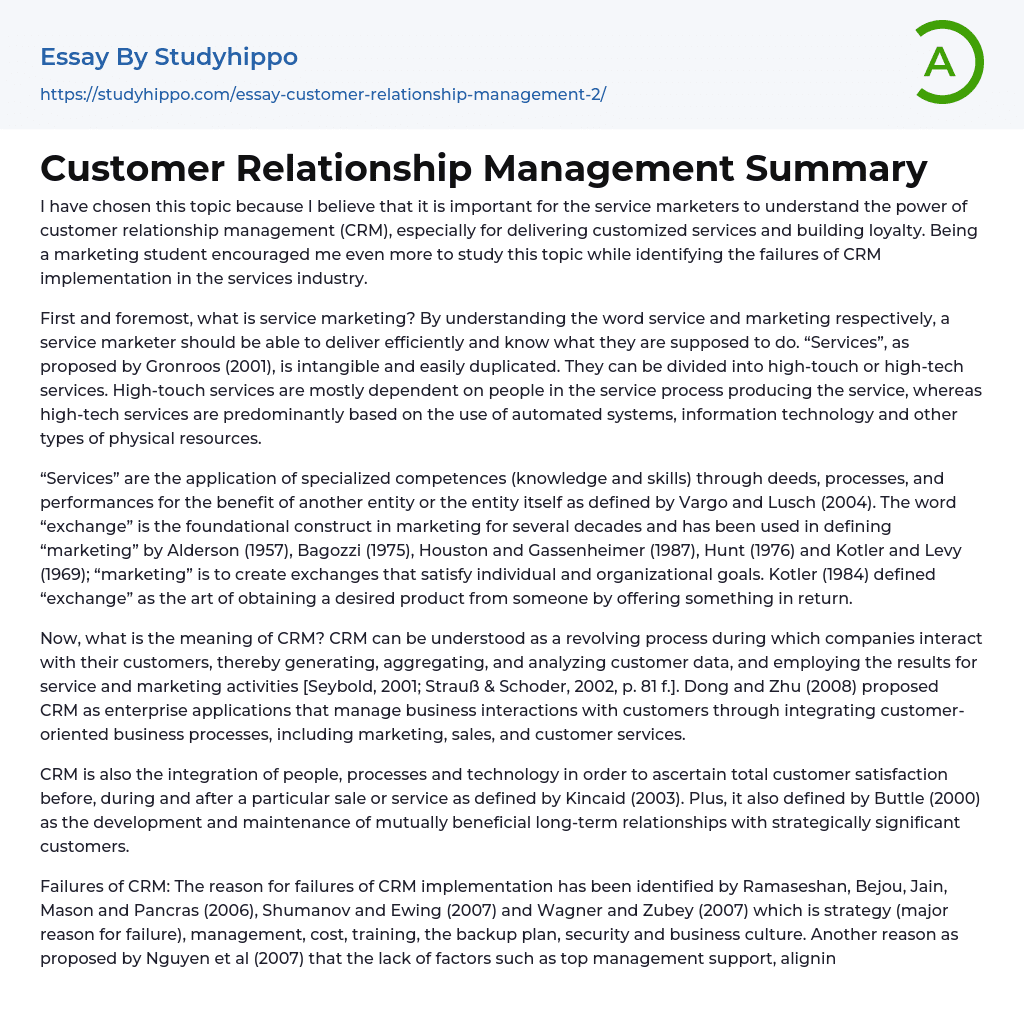I have chosen this topic because I believe that it is important for the service marketers to understand the power of customer relationship management (CRM), especially for delivering customized services and building loyalty. Being a marketing student encouraged me even more to study this topic while identifying the failures of CRM implementation in the services industry.
First and foremost, what is service marketing? By understanding the word service and marketing respectively, a service marketer should be able to deliver efficiently and know what they are supposed to do. “Services”, as proposed by Gronroos (2001), is intangible and easily duplicated. They can be divided into high-touch or high-tech services. High-touch services are mostly dependent on people in the service process producing the service, whereas high-tech services are predominantly based on the use of automated systems, information technology
...and other types of physical resources.
“Services” are the application of specialized competences (knowledge and skills) through deeds, processes, and performances for the benefit of another entity or the entity itself as defined by Vargo and Lusch (2004). The word “exchange” is the foundational construct in marketing for several decades and has been used in defining “marketing” by Alderson (1957), Bagozzi (1975), Houston and Gassenheimer (1987), Hunt (1976) and Kotler and Levy (1969); “marketing” is to create exchanges that satisfy individual and organizational goals. Kotler (1984) defined “exchange” as the art of obtaining a desired product from someone by offering something in return.
Now, what is the meaning of CRM? CRM can be understood as a revolving process during which companies interact with their customers, thereby generating, aggregating, and analyzing customer data, and employin
the results for service and marketing activities [Seybold, 2001; Strauß & Schoder, 2002, p. 81 f.]. Dong and Zhu (2008) proposed CRM as enterprise applications that manage business interactions with customers through integrating customer-oriented business processes, including marketing, sales, and customer services.
CRM is also the integration of people, processes and technology in order to ascertain total customer satisfaction before, during and after a particular sale or service as defined by Kincaid (2003). Plus, it also defined by Buttle (2000) as the development and maintenance of mutually beneficial long-term relationships with strategically significant customers.
Failures of CRM: The reason for failures of CRM implementation has been identified by Ramaseshan, Bejou, Jain, Mason and Pancras (2006), Shumanov and Ewing (2007) and Wagner and Zubey (2007) which is strategy (major reason for failure), management, cost, training, the backup plan, security and business culture. Another reason as proposed by Nguyen et al (2007) that the lack of factors such as top management support, aligning internal processes, linking CRM project to organisation’s higher-level strategies, focus on ROI (Return on Investment), achieving success early in the project.
Chalmeta (2006) has supported some of the previous failure causes as he pointed out the following factors as causes for CRM failure: thinking of CRM as a pure technology, lack of management support (same as Nguyen et al, (2007)), lack of customer-centric culture, lack of readiness process, poor quality data, lack of change management, lack of vision and strategy, and lack of involving the final user in designing CRM solutions. Agarwal, Harding and Schumacher (2004) discovered that cultural changes being one of the factors that caused CRM implementation a failure.
Without managerial commitment, any implementation of CRM strategies is thought to be deemed as a failure as argued by Chen and Popovich (2003).
Furthermore, organizational change, companies’ policies or inertia, little understanding of CRM and poor CRM skills were the main causes of failures of CRM implementation Mishra and Mishra (2009). King and Burgess (2007) suggested that the reason for failure in CRM implementation is the role of information system. Day, G (2000) suggested that suggests that main reason for CRM project failure is the lack of strategic planning prior to the implementation of CRM while Maselli, J (2001) found that the reasons for failure of many CRM initiatives ranged from technological implementation problems to a lack of organisational integration and customer orientation.
Conclusion: A social marketer has to be aware and active to avoid all the failures mentioned which are the weaknesses as it is the first step towards successful CRM implementation. CRM really do helps a lot in any services sector as it creates the bond with customers and making them loyal. Managers too have to learn and understand CRM as it also helps their companies to create a two way interactions with customers. Despite that, in any way, firms need to watch out for their CRM strategies as it will risk the customers to feel harmed and discomfort.
- Being A Leader essays
- Servant Leadership essays
- Leadership Experience essays
- Leadership Qualities essays
- Advertising essays
- Audience Theory essays
- Competitor Analysis essays
- Consumer essays
- Marketing Management essays
- Marketing Mix essays
- Marketing Plan essays
- Marketing Research essays
- Marketing Strategy essays
- Point Of Sale essays
- Price essays
- Procurement essays
- Product essays
- Product Differentiation essays
- Promotion essays
- Promotion And Marketing Communications essays
- Retailing essays
- Trademark essays
- Anheuser-busch essays
- Brands essays
- Detergent essays
- Product Placement essays
- Research Design essays
- New Product Development essays
- Advertisement essays
- Brand essays
- Sales Promotion essays
- Advertising campaign essays
- Consumer behaviour essays
- Offer And Acceptance essays
- Wal-Mart essays
- Discover essays
- Appreciation essays
- Customer essays
- Customer Satisfaction essays
- Customer Service essays
- Target Market essays
- Board Of Directors essays
- Brand Management essays
- Business Ethics essays
- Business Management essays
- Change Management essays
- Comparative Analysis essays
- Decision Making essays
- Dispute Resolution essays
- Knowledge Management essays




